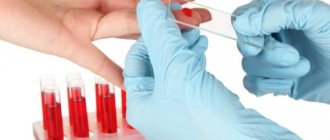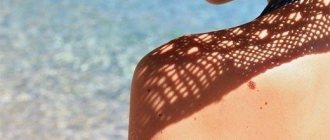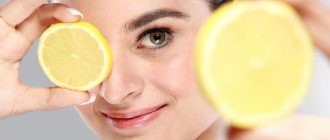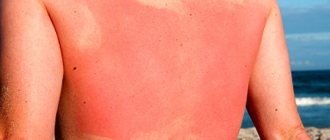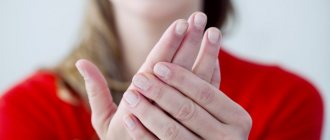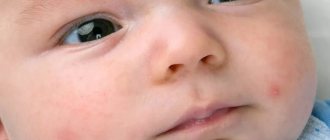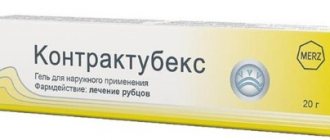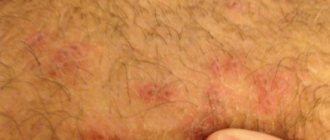Women look forward to summer vacation not only to take a break from work, but also to get a bronze tan, which is guaranteed after a trip to the sea.
It has long been no secret that ultraviolet radiation is very beneficial for the body, but along with the benefits, there is also a high risk of burns, damage to the skin, and even the development of malignant formations. People often encounter manifestations of photodermatosis - an allergic reaction to exposure to sunlight, which peaks in the first month of summer.
Patchy tan: etiology
If red spots are found on the skin after sunbathing, there may be several reasons for such symptoms, and the most popular are:
- Sunburn, which every person who enjoys sunbathing has encountered at least once in their life. Thus, under conditions of prolonged exposure to the skin, redness and the appearance of blisters are observed. Sunburn may also be indicated by accompanying symptoms such as headache, nausea and weakness. In this case, there is no serious reason for concern, because the unpleasant symptoms disappear after a few days.
- Excessive production of melanin in the body against the background of various diseases of internal organs. If, after sunbathing, red spots of a darker shade than the skin color appear, it is recommended to conduct examinations to identify the root causes. As a rule, such symptoms can be caused by disorders of the liver and thyroid gland.
- Taking hormonal drugs, antibiotics and sedatives. Red spots on the face after sunbathing are often the result of treating the skin with various cosmetics immediately before going to the beach. Low-quality tanning products and perfumes can also cause the same effect.
Allergy to the sun
Red spots on the skin after sunbathing are the main symptoms of an allergic reaction to ultraviolet radiation. Not everyone is familiar with this term, and many will even be surprised that there could be an allergy to such a pleasant pastime, but it is true. Of course, the sun's rays cannot be classified as allergens, but they contribute to the accumulation of the latter.
Just a few centuries ago, humanity was not familiar with allergens in the quantities in which the modern population encounters them. Such disappointing changes are caused by poor ecology, poor-quality food, and constant stress. As a rule, against the backdrop of unfavorable circumstances, the risk of an allergic reaction increases significantly.
Sunlight is a source of vitamin D, which is essential for the human body. In this case, we are talking exclusively about moderate doses. If red spots appear when tanning, then most likely there was an excess of the vitamin or an unsatisfactory state of the body.
Red spots on the body after sunbathing most often appear in people with low protective forces, as well as with impaired functioning of the liver and kidneys. Often, red spots on the legs after sunbathing and other parts of the body bother people who have very fair skin, moles and freckles. In this case, prolonged exposure to sunlight is contraindicated and it is better not to ignore this recommendation.
Most often, the first manifestations of an allergic reaction can be found after half an hour, but in some cases a person experiences unpleasant symptoms only after 12 hours or more. Red spots after tanning in the sun are considered not the only manifestation of an allergy to ultraviolet radiation, which is accompanied by the formation of blisters, burning and itching.
Treatment and prevention
It is necessary to immediately stop exposure to sunlight if red spots appear after sunbathing. A photo of these allergic symptoms will help you figure out in which cases red spots should be attributed to a fairly serious pathological condition. If red spots appear on the chest after sunbathing, which can be attributed to manifestations of an allergy to the sun, then in the future you should always remember about precautions. Sunbathing in the sun without first treating the body with special means is strictly not recommended for people with allergies.
Treatment of sun allergy should be carried out only after the root causes of the appearance of characteristic symptoms have been established. The main therapeutic measures are presented:
- Treating the skin with ointments based on lanolin and zinc to eliminate itching, burning and redness.
- By applying hormonal ointments to the skin, which are prescribed to patients if necessary due to the condition of the body.
- Taking certain medications that are prescribed to patients with diagnosed kidney and liver dysfunction.
- Taking therapeutic agents that improve metabolism and regenerate damaged skin.
- Taking vitamins, among which the most essential are vitamins B, E and C.
- The use of indomethacin and aspirin, which help reduce inflammatory processes on the skin.
- Eliminate severe itching with herbal baths based on string, valerian, sage and chamomile.
Rules of procedure in the solarium
The rules for visiting the solarium are simple and clear. But despite this, you must adhere to these tips:
- set the timer depending on your skin type; the more sensitive it is, the less time you can spend under UV lamps;
- checking the newness of ultraviolet lamps; the newer they are, the more intense the irradiation;
- selection of protective cosmetics that prevent excessive tanning, rather than stimulating the appearance;
- avoid solarium after cosmetic procedures (peeling, laser therapy);
- take care of restorative cosmetics after tanning.
Compliance with these rules guarantees a pleasant and useful pastime. The consequences in the form of red rashes from the procedure can be viewed in photos on the Internet.
Types of reactions to the sun
The reaction to the sun's rays can be in the form of rashes of various shapes and colors.
Solar urticaria comes in the following types:
- Red rash after sunbathing. In most cases, this is how an allergy to ultraviolet radiation manifests itself. Rashes can appear either immediately or several hours after sunbathing. If you are allergic to the sun, be sure to use sunscreens with a high degree of protection, as well as sunbathe under an umbrella.
- White rashes after sunbathing. Such spots can appear from both natural and artificial ultraviolet radiation. Mostly white rashes occur during prolonged exposure to intense sunlight. May appear on various parts of the body. The most important thing is to sunbathe only before 10 a.m. or after 4 p.m. to avoid unpleasant skin reactions.
- Watery rashes. This is the first sign of sunburn. First there is redness and swelling. Then blisters appear on the skin, which gradually fill with liquid. Eventually, the blisters begin to burst and peel off, leaving open wounds. In addition, body temperature may rise and general health may deteriorate. The most important thing is not to pierce the blisters yourself, so as not to cause an infection and lead to an inflammatory process. In order to avoid the appearance of blisters, you need to apply an anti-sunburn remedy, for example, Panthenol, to the reddened skin. The product will quickly relieve all symptoms of sunburn and stop the inflammatory process.
Signs of the disease
Main symptoms of sunburn:
- Swelling and redness of the skin.
- Red dots on the skin after sunbathing
- Pigment spots of a red or brown hue.
- Blisters filled with fluid.
- Increased body temperature.
- Headache and fainting.
Causes of the rash
Red spots may appear on the stomach, arms and face for the following reasons:
- Prolonged exposure to direct sunlight.
- Taking medications that affect hormonal levels and increase skin sensitivity to ultraviolet radiation.
- White skin prone to allergies and irritations.
- Not using sunscreen.
- Sunbathing during the lunch period, when there is an increased intensity of ultraviolet radiation.
Symptoms of solar urticaria
Sunburn is manifested by the following symptoms:
- First, red spots and swelling of the skin appear.
- Sunburns are accompanied by severe pain.
- Bubbles appear and gradually fill with liquid.
- Increased body temperature and deterioration in general well-being.
How to avoid getting burned
Burns and redness are very unpleasant. But how can you avoid getting sunburned in a solarium? You can get a tan in a solarium without harm to your health, the main thing is to be careful. Often you want to tan faster and precautions fade into the background.
To avoid burning your face and body in a solarium, and to prevent skin damage, you should follow simple rules for tanning in a solarium:
- The duration of stay under the lamps should be increased gradually. For the first time, the optimal time is 3 minutes. The maximum time spent under ultraviolet light is 10-15 minutes. Between sessions you should take breaks of 24 hours.
- You should only choose cosmetics that are special for tanning in a solarium; such products are available in every salon.
- Even if you don't feel any signs of a burn after tanning, it is recommended to apply after-sun cream or a cooling spray. This will restore the water balance in the epidermal cells.
- It is not recommended to carry out water treatments before visiting a solarium, and then use scrubs and peeling, as this can damage the skin.
Sensitive areas of the body should be protected:
- Use special glasses, as ultraviolet rays can harm your eyes.
- Solarium is very harmful to hair, so you must wear a cap during the procedure.
- To protect your breasts from harmful effects, use stikini - special stickers (or caps) for the nipples.
- For lips, balm or lipstick is suitable.
Treatment of skin rashes on the body
Treatment for sun allergies includes the following:
- First of all, you need to move the victim to a room with normal temperature and humidity.
- If redness and swelling occur, apply cold compresses. You can use plain water or medicinal herbs.
- Necessary treatment involves the use of medications that relieve redness and swelling after ultraviolet exposure.
- In order to relieve the symptoms of sunburn, ointments and creams are prescribed. Panthenol, Fenistil or Radevit are mainly used. They quickly eliminate swelling and red spots after ultraviolet exposure.
- In order to eliminate allergic reactions on the skin, antihistamines are prescribed, for example, Cetrin or Suprastin. They help eliminate red spots and pain after sun exposure.
- To restore the skin after ultraviolet radiation, vitamins are prescribed, for example, groups B and E. They maintain the youth and beauty of the skin and accelerate the process of regeneration of affected tissues.
- It is necessary to increase the drinking regime and cleanse the body of toxins. Sorbents are prescribed that remove toxic substances from the body.
Red dots on the skin after sunbathing, symptoms, causes, treatment, prevention
Having come to the solarium for a wonderful tan, many people return home with small reddish pimples, swelling and other pathological changes in the skin of the body; this is a manifestation of allergies after solarium .
Allergies after solarium can be caused by the following reasons:
- exposure to UV radiation. Directly, such rays are not allergens for the body, but when taking medications, they can cause an allergic reaction in the internal organs of a person.
- reaction to chemical facilities. The composition of antiseptic agents used to treat solariums or cosmetic preparations for the client’s skin often includes substances belonging to the group of allergens.
It should be noted that each type of allergy to solarium has certain symptoms and signs.
Variety of stains
Spots on the body can be classified as follows:
- Dark. Dark pigment spots appear when exposed to the scorching sun for a long time and are the result of a burn. Such spots appear mainly in the form of bubbles. The appearance of such marks on the skin is usually accompanied by severe headache, nausea and vomiting; after some time, these signs disappear on their own. Sometimes the appearance of dark spots after tanning is associated with pathologies of internal organs, in particular the thyroid gland and liver. Before going to sunbathe, it is not recommended to take any antibiotics, sedatives or hormonal drugs.
- Vitiligo. White spots or vitiligo are still not fully understood; it is not known whether they are a consequence of prolonged exposure to the sun or not. It is believed that disturbed pigmentation on the body indicates health problems and does not arise from tanning, but on the contrary, they become more distinct against the background of tanned skin, since they are practically invisible on light skin. They usually appear on the face, arms and legs; white spots can be seen extremely rarely on the body.
- Ringworm. This is an infectious disease in which small white spots appear on the body, resulting from the fact that ultraviolet rays do not reach the lesion, and the skin remains light. If you do not sunbathe, the covering of the spots with tinea versicolor is usually pink or flesh-colored. Since tinea versicolor is an infectious disease, it must be treated; antifungal drugs are usually used for its treatment.
- Poikiloderma Siwatt. This is another type of skin defect that occurs due to tanning. This defect manifests itself in the form of such a sign as white spots on the neck and chest. This manifestation is not a disease and does not require any specialized therapy. To avoid the appearance of white spots in the presence of such a skin defect, it is necessary to use sunscreen and try to ensure that the direct rays of the sun do not fall on the chest and neck.
- Often the reason why white spots appear on the body after sunbathing is long-term use of any medications or hyperhidrosis. In these cases, pigmentation appears mainly after visiting a solarium.
- Red spots after sunbathing are a direct result of an allergic reaction to ultraviolet rays. Often, such age spots on the body do not begin to appear immediately after sunbathing, but 12-15 hours after that. An allergy to ultraviolet radiation is manifested not only by the appearance of red spots, but also by such signs as blisters and burning, and after some time, severe itching at the affected area.
Basic ways to relieve redness after tanning
According to the degree of intensity, burns after tanning can be divided into several types:
- Redness of the skin;
- Redness, pain and itching;
- Redness, pain, itching and blistering;
- Charring is the most terrible of burns.
The first two types are easier to tolerate than others; they can be treated independently at home.
How to quickly remove redness if the skin is burned in a solarium? There are some rules that will help get rid of redness after an unsuccessful stay under ultraviolet lamps:
- You should drink more fluids, this will help restore your water balance, since a burn, especially a large one, causes dehydration. Diluted juices, warm green or black tea, mineral water are good, but it is better to exclude alcoholic drinks.
- The use of medications against burns will help eliminate burning and pain, as well as speed up the healing process; it is optimal to choose products with panthenol or aloe juice. If touching the damaged area is painful, use spray medications.
- If you don’t have any special preparations on hand, you can use baby cream; masks made from cucumber or raw potatoes, low-fat kefir and sour cream work well against burns.
- For mild redness, a cool shower or bath without the use of soap and gel, which will further dry out the skin, will help soothe and cool the skin. When taking a bath, it is optimal to add half a glass of soda and chamomile decoction; they will have a calming and softening effect.
- Affected areas of the skin should be lubricated with medical or folk remedies every 2-3 hours for better healing.
- For severe pain and itching, any painkiller will help; if the redness is caused by an allergic reaction, then you need to take an antihistamine.
- If your facial skin is burned after tanning, you should not use decorative cosmetics until the burn heals.
- You should forget about the solarium for a few days so that damaged skin has time to return to normal. And also try to avoid prolonged exposure to the sun.
If you notice severe redness after a tanning salon, and the burn in general is very strong, a lot of blisters appear, it is strictly forbidden to pierce them, you can get an infection, which will lead to inflammation and suppuration.
If watery formations are damaged, you feel unwell, nausea, dizziness and high temperature, you should immediately consult a doctor!
Herbal cold compresses
If the skin of your face or body is burned in a solarium, it is recommended to apply compresses to soothe and restore it. Cold compresses made from herbal infusions are an excellent way to relieve redness after an unsuccessful visit to the solarium:
- Knotweed
. Add 2 tablespoons of herbs to 300 ml of boiling water, cover with a lid, leave for 5-10 minutes. When it cools down, you can apply it to the burned area of the skin. - Chamomile or calendula
. Pour one tablespoon of the plant into a glass of boiling water. Wrap in heat and leave for 15 minutes, then strain and let cool, after which you can use. - Cabbage
. Soak gauze in squeezed cabbage juice and apply to damaged skin, or use whole cabbage leaves.
Masks for burnt skin
Masks can also help remove redness if your face or body is burned after a solarium. But not just any, but specific ones will do:
- Oatmeal mask.
Mix 3-4 tablespoons of oatmeal and 0.5 liters of boiling water. Cook until foam appears on the surface, collect it and lubricate the damaged areas. Oatmeal decoction relieves pain and itching. - Honey mask.
Mix 1 glass of fresh milk and 2 glasses of water, add 2 tablespoons of honey. Cool the prepared mixture. To apply to the body, soak gauze in the mixture and apply for 10-15 minutes. Do the mask several times a day. The mask should be stored in the refrigerator. - Aloe mask.
To prepare the mask, you will need fresh aloe leaves; they can be crushed into a paste in a blender. Apply the mask to the burned areas, not allowing it to dry out - either rinse the mask with water or apply another layer. - Egg mask.
You should choose fresh eggs, separate the whites for the mask and beat a little. Just like the aloe juice mask, the egg white mask should not dry out.
Using the above folk remedies, you can do procedures to quickly restore skin that has been burned in a solarium.
So you have learned how to remove redness from your face or body if your skin is burned in a solarium. By following simple rules of skin care after tanning in a solarium, you can achieve a speedy recovery. Follow the above recommendations, and in a short time your burned skin will regain its softness and elasticity.
Follow the rules for visiting the solarium. Remember that burns and redness are easier to prevent than to treat.
Drug therapy
Treatment of pigmentation on the skin resulting from sunburn should begin only after the exact cause of its appearance has been established.
- Treating the skin with ointments based on zinc and lanolin, which can effectively eliminate burning and itching. In some cases, it becomes necessary to apply hormonal ointments to the affected areas of the skin. Aspirin and Indomethacin effectively eliminate all inflammatory processes on the skin.
- For kidney and liver diseases, special therapy is prescribed with the necessary medications, as well as medications to improve metabolism and restore damaged skin, and take vitamins such as B, C, and E.
Diagnosis of the disease
The dermatologist first collects anamnesis. Questions the patient about periods of exacerbation, the connection between the onset of symptoms and the use of medications and the use of cosmetics.
Before treatment of photodermatosis, the disease is diagnosed:
- take general blood and urine tests;
- determine the level of antibodies in the blood during an immunological study;
- check the skin's reaction to UV radiation using a photo test;
If it is assumed that the cause of the allergy is the accumulation of drugs in the skin, photoapplication tests are performed. If there is a suspicion of insufficiency of kidney or liver function, an ultrasound scan is performed.
Treatment with folk remedies
Traditional therapy in the fight against age spots that appear after sunburn is very popular. The most common ones are:
- Yeast mask. This mask is very effective when red or dark brown pigment spots appear on the skin due to sunburn. When preparing a product from yeast, you should take into account your skin type: for oily skin, yeast is diluted with hydrogen peroxide, and for dry skin, with plain water. The finished mask is applied to the damaged area of the skin and left until completely dry, and then washed off with warm water. The procedure can be carried out every other day until the spots completely disappear.
- Mustard powder mask. The pink spot that appears after tanning can be removed using a mustard mask. To prepare it, you need to dilute dry mustard powder with water to a paste and apply to the skin for 15-20 minutes. Before using such a mask, it is important to remember that it should not be applied to excessively dry skin and those areas of the body where there is excessive hair.
- Curdled milk and dill. Fresh dill must be finely chopped and mixed with a glass of yogurt; the resulting mask can be applied to the skin several times a day. This product not only perfectly removes pigments that appear after a sunburn, but also effectively cools the skin.
- Cucumber. This vegetable has both cooling properties and removes white spots from tanning. In order to prepare a mask, you just need to grate a cucumber and apply the resulting mixture to problem areas. After 15 minutes, wash off the paste and prepare a fresh one. Such approaches need to be done 3-4 times in a row.
- Fruit peeling. With this peeling you can achieve excellent results in the fight against spots that may appear after sun tanning. To prepare the procedure you need to take: 100 g of pineapple, 50 g of papaya and liquid honey. Pineapple and papaya must be thoroughly mashed and mixed with honey. For the first time, you cannot keep peeling on problem areas of the skin for more than 3 minutes; subsequently, this time can be extended to 5 minutes.
Effective ways to combat redness after tanning
It is not always possible to follow safety precautions. If it was not possible to protect the skin and red spots have formed on it, proceed with immediate treatment.
Cosmetical tools
The salon where you go for treatments sells special products for safe tanning in a solarium. They must be applied before you enter the cabin. If you haven't done this, purchase an ointment or cream to relieve redness. They have a pleasant smell, are suitable for tanning in a solarium and perfectly soothe the skin. The composition is sold both in single-use sachets and in whole bottles. Apply it to the skin, do not rub, allow it to be completely absorbed.
Dairy products
Lubricate the affected areas with a generous layer of rich sour cream, wait until the mixture is absorbed into the skin. When the first layer dries, apply the next one. If the pain from the slightest touch to the skin subsides, the procedure can be considered complete. The composition can only be removed with cool water. You can also use fermented baked milk mixed with cottage cheese. All fermented milk masks are best performed in the bathroom. The negative side of the procedure is considered to be an unpleasant odor, but it disappears after bathing with shower gel.
Pharmacy products
Rescuer ointment and Panthenol cream will help soothe the skin. Apply the product to the skin and leave until completely absorbed. The redness will disappear in about 4-5 hours. Any aloe vera-based healing ointment will also work. You can use freshly squeezed juice of the plant or its crushed pulp. In this case, the product is applied as a mask and left for 45 minutes.
Natural oils
The best option of all available traditional medicine. Natural oils include olive, sunflower, camphor, sea buckthorn, burdock, and corn. Choose any or combine several options with each other. Apply the composition to the skin, rubbing gently. Wait 1 hour, then gently rinse the mixture with cool water and soap or shower gel.
Apricot or peach
Using a blender or meat grinder, grind 300 g. fruit. Remove the seeds first, but leave the peel on. Make a mask, wait 1 hour (more is possible), rinse off the mixture.
Cosmetic ice
Rubbing with ice cubes relieves redness, tones and smoothes the skin. Brew 50 g. black or green tea in 500 ml. boiling water, leave for 20 minutes. Cool, pour into molds, freeze. Apply ice to the affected areas several times a day for 5-10 minutes.
Medicinal herbs
Prepare a decoction of medicinal herbs, brew, cool and strain. Fold gauze or cotton cloth in several layers, moisten it, and make a compress. Wait 40-60 minutes.
Let's look at the most effective formulations:
- thuja cones, thyme, fresh parsley;
- yarrow, geranium, magnolia, rose flowers;
- dried garlic, cuckoo flax, burdock;
- chamomile, rosemary, coltsfoot;
- honeysuckle, sage, lemon balm.
Take plants in equal proportions, pour boiling water at the rate of 20 grams. each herb per 100 ml. water. If desired, you can add 1 or 2 tablespoons of any oil. The procedure must be repeated every 2 hours.
Baby cream
The method is suitable for those who have a less pronounced red tint. If the skin is slightly pink, lubricate it with baby cream. He can cope with the task in a short time. The composition is not suitable for severe damage.
Potato
Grate or mince 4 medium-sized raw potato tubers. Mix them with milk, cover the skin and wait 30 minutes. After this, wash yourself with cold water and apply healing ointment. You can replace raw vegetables with freshly cooked and chilled ones.
Watermelon
Cut the fruit into several wide slices and remove the peel. Stand in the shower or bath and gently wipe the damaged areas of the skin for 10-15 minutes.
Strawberries, raspberries or currants
Take 200 gr. any fresh berries, grind them into puree. Apply to skin, leave for 40 minutes until partially dry. Gently rinse off the mixture, apply corn oil and wait another 25 minutes. Wash off the mixture with shower gel.
Preventive actions
The main objective of preventive measures in this situation is to prevent the occurrence of an allergic reaction to the sun, and therefore it is recommended to use sunscreen before going outside in the summer. After a walk in direct sunlight, apply a nourishing moisturizer to your skin.
Low-quality sunscreens can also cause an allergic reaction in the form of stains, so you should purchase them only from trusted stores or pharmacies. Often the cause of stains is perfume, so before going to sunbathe, it is not recommended to use perfume and eau de toilette.
You should try to be in the sun only at strictly designated times, i.e. before 11 a.m. and after 3 p.m. The most optimal time spent in direct sunlight is 25-30 minutes.
Symptoms characteristic of allergies
Year-round sunbathers are wondering whether it is really possible to be allergic to solariums? The disease that occurs after tanning under the sun's rays or UV lamps manifests itself in the form of a type of dermatosis - photodermatitis (see in more detail “Causes and treatment of sun allergies in adults”).
Allergy to solarium, in turn, is expressed by symptoms, often multiple, less often individual:
- redness of the face, areas of skin on the body, the formation of pink spots that merge into swollen lesions immediately after leaving the booth or after 10–30 minutes;
- the appearance of small watery or purulent pimples;
- localization of itching and burning during skin inflammation in the décolleté area and other places with delicate skin;
- hyperthermia;
- swelling of the epidermis;
- dry skin, peeling, which can be eliminated by taking a shower or using a nourishing cream.
The most dangerous, rarely occurring sign of an allergy in a solarium is swelling. If this symptom appears, it is recommended to consult a doctor immediately. Elevated body temperature can be either a sign of an allergic reaction or a consequence of overheating. In this case, they focus on the presence of accompanying signs.
Symptoms most often appear on the face, chest, inner bends of the elbows, and behind the knees. The rash also covers the neck, arms, shoulders and legs.
Allergy to henna for eyebrows
To color eyebrows, different types of henna are used, which have different compositions. Usually the composition includes natural ingredients. However, women an allergy to eyebrow henna (photo 3) even when using natural substances. Usually an allergic reaction develops to black henna. However, when using any variety, a sensitivity test is required. When an allergy occurs, the following symptoms may occur:
- spasmodic cough;
- dyspnea;
- hyperemia in the eyebrow area;
- swelling;
- burning, peeling, itching;
- conjunctivitis, allergic rhinitis.
With prolonged contact with henna without treatment, complications may develop that contribute to deterioration of health. Usually an allergy occurs to the chemicals, and not to the paint itself. Therefore, you need to carefully study the composition and give preference to paints from well-known brands to avoid allergies to henna.
Allergy to eyelash extensions
Typically, an allergic reaction does not occur to the eyelashes themselves, but to the glue used in the extensions. The immune system reacts to the chemicals contained in it. Due to this, immune defense is developed, which manifests itself as allergy symptoms.
Allergy to eyelash extensions (photo 4) develops quite rarely. This only happens when using unnatural hairs. Allergy to eyelash extensions has the following symptoms:
- severe redness and dryness of the mucous membrane after the procedure;
- itching and swelling of the eyelids, which often spread to the entire face;
- increased lacrimation;
- temperature increase.
An allergy develops in the eyes, but there is no pain. If such symptoms occur, then this is not an allergy. Most likely, the master did his job incorrectly. In addition to eyelashes, girls love to do nail extensions and shellac. Some people may develop an allergy to shellac and nail extensions, but this is quite rare. Usually the symptoms are not dangerous. If it appears, you need to stop contact with the allergen and consult a doctor.
Historical background: when did sunbathing begin to be considered beneficial to health?
Carefully protecting your skin from the sun was a social norm a century ago. Until the beginning of the twentieth century, tanning was treated with great suspicion: women tried in every possible way to protect their skin with mittens, dresses and blouses with long sleeves, and summer umbrellas. Aristocratic pallor was one of the main signs of belonging to the highest circles of society, while tanning was the prerogative of peasants, farmers and other commoners.
The situation began to change after the First World War. At that time, many city women were forced to go to the countryside to do field work, because due to the lack of men, there was not enough labor. In addition, around the same time, Dr. Auguste Rollier proposed a new method of treating tuberculosis through sunbathing.
One of the unwitting popularizers of tanning was Coco Chanel. One day her skin got sunburned, but high society considered it a new fashion for tanning. The so-called “healthy tan” became the hallmark of successful and wealthy people who could afford not to pore over papers in offices, but to travel and laze on the beach. Another reason for the popularization of prolonged exposure to the sun, dark skin and tanning were Egyptian and African motifs, which became fashionable in European art in the 20s of the twentieth century.
Prevention
How to protect skin covered with birthmarks and sensitive to ultraviolet radiation from developing solar urticaria? The most objective way is to spend less time in direct sunlight and walk in the shade. Supportive measures to prevent photodermatosis:
- wear clothes made from natural fabrics;
- do not visit solariums;
- stick to a protein-vegetable diet;
- drink at least 2-2.5 liters of liquid in hot weather;
- treat your skin with sunscreen before going outside;
- wear a hat and light clothing with closed sleeves;
- consume more diuretic foods and drinks;
- harden the body;
- Dry your skin thoroughly with a towel after swimming in public waters.
Rash due to sun
In summer, many people head to the sea to get an even tan.
But sometimes it happens that a rash from the sun appears on the surface of the skin. It is associated with increased sensitivity of the body to sunlight. The body's reaction is allergic. Manifestations can occur several hours or days after exposure to the sun. Treatment should be prescribed by a doctor after assessing the condition of the skin and making a diagnosis.
Sun rays can cause various changes on the surface of the skin. Increased sensitivity is called photosensitivity. Changes can come in several forms.
- Phototraumatic reactions include sunburn. They can form in any person with prolonged exposure to ultraviolet radiation on the surface of the skin. Pimples and sun blisters appear on exposed areas of the body.
- Phototoxic reactions are provoked by the consumption of certain foods, plants, and medications that are photosensitizers. In this case, extensive solar urticaria appears on the surface of the skin.
- When the skin does not tolerate sunlight, a photoallergic reaction develops. It is associated with immune disorders, as a result of which the body reacts negatively to exposure to the sun. Papules, vesicles, and weeping areas form on the surface of the skin. Lichenification of the skin can also be pronounced, in which the tissue thickens, roughness and pigmentation appear.
Symptoms of solar urticaria
The symptoms of solar urticaria can vary. They appear depending on the causes of the rash, the person’s age, and other factors. In most cases, allergies manifest themselves in the form of standard symptoms.
- The skin becomes red, rash-like, inflamed and itchy.
- Sun acne appears on the surface of the skin. They are localized mainly on open parts of the body: on the hands, face. But when you are on the beach, roughness, unevenness, and swollen lesions appear all over your body and back. The areas may become very itchy and painful.
- With severe damage, the skin becomes covered with crusts and scales. Blood may leak from injured areas.
Often an allergic reaction manifests itself as hives from the sun. But eczema and the formation of blisters are also noted.
When exposed to the sun, the skin may become red and break out in rashes.
If ultraviolet irradiation occurs to a strong degree, then the rashes are localized even in those places that were not exposed to rays.
The most common signs shown in the photo may have varying degrees. Changes vary from the amount of ultraviolet radiation exposed, the duration of exposure to the sun and the individual characteristics of the body.
Causes of the rash
Healthy people whose immune systems are not weakened are less likely to have an allergic reaction to sunlight. Violations occur especially often in:
- people with light skin and hair tones;
- newborns and infants;
- pregnant women;
- solarium lovers;
- women after tattooing, chemical peeling;
- old people.
An allergic reaction is accompanied by itching
Solar urticaria can be triggered by internal disorders in the body. Therefore, people suffering from liver and intestinal pathologies and a decrease in the body’s immune defense are susceptible to it. Allergies also appear with vitamin deficiency, hidden chronic diseases, and metabolic disorders.
Changes in the skin are associated with the presence of photosensitizers in the body. These agents cause problems with the skin when exposed to the sun.
The substances are found in various foods, medications, and medicinal plants. When they are consumed, a reaction occurs in the body, after which acne from the sun appears.
Many drugs have photosensitizing properties
Many drug manufacturers indicate in the instructions that the drug causes photosensitivity. Therefore, when exposed to ultraviolet light, a person taking the pill may develop sun-induced hives.
Among these drugs are:
Read more:Red rash on stomach
- contraceptives containing hormones (COCs);
- antibiotics (fluoroquinolones, tetracyclines, macrolides);
- antifungal agents;
- non-steroidal anti-inflammatory drugs;
- antihistamines (Diphenhydramine, Promethazine);
- cardiac medications (fibrates, amiodarone, digitoxin, atorvastatin);
- sedatives and antidepressants;
- thiazide diuretics;
- drugs for the treatment of diabetes mellitus;
- essential oils;
- corticosteroids.
In addition, a similar effect is observed when using boric and salicylic acids, methylene blue, and tar-containing ointments.
Meadow grasses cause sun rashes on the skin
The appearance of spots on the skin can be observed when furocoumarins, which are produced by meadow grasses, come into contact with the skin. To prevent a person from breaking out, you should protect yourself from contact with:
- nettle;
- buckwheat;
- quinoa;
- hogweed;
- fig tree
In addition, you should not be in the sun if a person takes decoctions and infusions of St. John's wort, angelica, clover, sweet clover, and agrimony.
Some foods also have a provoking effect. Among them are:
- carrot and citrus juices;
- Bell pepper;
- sorrel;
- parsley;
- celery;
- spicy foods;
- alcohol;
- products containing dyes, preservatives and sweeteners.
People suffering from an allergic reaction to coffee, chocolate, or nuts need to be especially careful.
If a person’s back is burned due to prolonged exposure to the sun, then no special treatment is required. After all, this reaction can be observed in anyone who overdoes it with tanning. In this case, you will need to apply sunburn products to your skin.
Before you figure out what to do about blisters after sunburn, you need to determine the true cause of the skin reaction. When consuming photosensitizers, you should avoid these substances. If this is not possible, protection from the sun's rays is necessary in the form of creams, capes, and hats.
If acne appears from the sun, you should consult a doctor. He will assess the symptoms of the lesion and select the necessary treatment for solar urticaria. It can be carried out using various groups of medications.
Local remedies
For mild skin damage, especially on the face, from the sun, unpleasant symptoms can be relieved with the help of non-hormonal ointments and creams. They soothe the skin, cool its surface, eliminate itching and rashes. Among the means in this area are:
- Fenistil-gel;
- La-cree;
- Panthenol;
- Radevit;
- Dexpanthenol.
You can treat sunburn with the help of special preparations Psilo-balsam, Solcoseryl, Karatolin.
After a burn, soothing agents can be applied to the skin
If a severe allergic reaction occurs, the use of corticosteroids will be required. The drugs have a strong effect, so they are prescribed only by a doctor for a short time. These include:
- Fluorocort;
- Betamethasone;
- Hydrocortisone;
- Advantan.
If you overdose on these drugs, your skin condition may worsen. Due to habituation, the integument can atrophy.
If an allergic reaction occurs, an allergist and dermatologist may prescribe antihistamines:
- Claritina;
- Suprastina;
- Cetrina;
- Zodaka.
They block the production of histamine in the body, which prevents the allergic reaction from developing further.
Antihistamines relieve itching and rashes
Taking vitamins
Allergies and rashes can be a consequence of vitamin deficiency in the body. Therefore, complex treatment should include mandatory intake of vitamins C, E, nicotinic acid and group B.
Enterosorbents
To speed up the removal of the irritant from the body, enterosorbents are prescribed. Among them, the most effective are:
- Polysorb;
- Polyphepan;
- Filtrum;
- Enterosgel.
They need to be washed down with enough water to quickly wash away hazardous substances.
Folk remedies
You can get rid of rashes using folk remedies. They are used only if a person is not allergic to herbs and medicinal plants.
- You can take a nettle decoction internally. You need to brew a tablespoon of the plant’s flowers with 200 ml of boiling water. After 30 minutes of infusion, take a decoction of 1/2 cup up to five times a day.
- Lotions made from nettle decoction (30 g of leaves per 0.5 liter of water) are useful. The composition is brought to a boil and then infused for an hour. A cotton pad is soaked in the decoction and applied to the surface of the skin. The product can be used for both the body and face.
- You can replace regular tea with a decoction of the string.
Folk remedies help to cope with rashes
Prevention
To eliminate the possibility of rashes after being in the sun, you need to follow simple prevention rules.
To eliminate the possibility of a rash, you need to lubricate your skin with sunscreen.
- Sunbathing is allowed for no longer than 20 minutes. The optimal time for sunbathing is before 10 am and after 5 pm.
- It is prohibited to use decorative cosmetics and perfume before going outside.
- Sunscreens must have a high degree of protection. They need to be applied 20 minutes before going out.
- After bathing, there is no need to completely wipe the water off the surface of the skin.
If you are unable to protect yourself, you should immediately consult a doctor. Otherwise, the allergy may only get worse.
Source: https://postpk.ru/zdorovye/syp-solnca
Is it possible for someone with allergies to visit a solarium?
It is not recommended to visit the establishment during the remission stage:
- For oral dermatitis (rashes around the mouth and in the area of the nasolabial triangle). Pigment spots form in place of former acne.
- Patients with atopic and seborrheic dermatitis. Skin exposed to ultraviolet irradiation becomes dry and itchy, aggravating the painful condition;
- Allergy sufferers with photodermatitis. Rashes and skin inflammation go away on their own within 2 weeks, but symptoms return after visiting a solarium or the beach. With frequent procedures, the allergy becomes chronic.
In people with an increased reaction of the immune system, ultraviolet light complicates disorders and leads to new reactions to the allergen. This applies not only to patients with skin diseases, but also to people with allergic rhinitis, conjunctivitis, bronchitis and food allergies.
If an allergy to the sun appears more than once, this is a signal that you should not visit a solarium. A single case of mild photodermatosis is not an absolute contraindication to tanning. When you return to the solarium, security measures are strengthened. If signs of an allergic reaction appear again, you should avoid tanning, as the risk of developing eczema increases.
Solarium is contraindicated for allergies in the acute phase of disease progression.
Solarium during pregnancy
There are several opposing opinions about the benefits and harms of artificial tanning while a woman is pregnant.
From one point of view, in winter, dosed ultraviolet rays satisfy the need for vitamin D, which is necessary for both mother and baby. From another point of view, the negative impact of ultraviolet radiation on the fetus has not been fully studied, so women during pregnancy need to take special care so as not to harm their own health and the body of the baby.
In the absence of allergies to solariums, chronic diseases and contraindications for using solariums, dosed ultraviolet rays will not harm the patient. However, it is necessary to follow certain safety rules, including the mandatory wearing of swimsuits, glasses, and the restriction of women’s use of perfumes and cosmetics.


